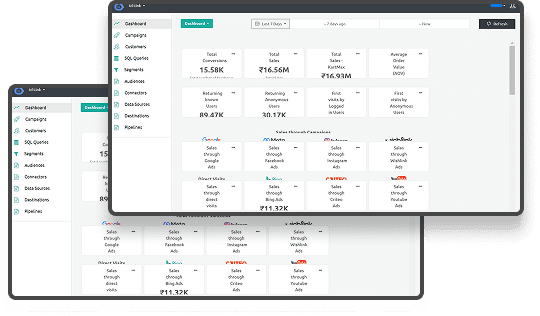Understanding Cross-Domain Cookies and How They Work
Are You Prepared for the Shift in Cross-Domain Cookie Compliance?
Managing user data across multiple platforms has become increasingly challenging for businesses. Due to growing privacy concerns and regulatory changes, the traditional reliance on third-party cookies for tracking and personalization is being scrutinized.
Over 20 U.S. states have enacted comprehensive consumer privacy laws, each with unique requirements for data handling and user consent. This patchwork of regulations complicates the process for businesses aiming to maintain compliance while delivering consistent user experiences.
Consumer behavior is also evolving. Studies indicate that nearly 70% of users either ignore or close cookie consent banners, potentially limiting the effectiveness of traditional tracking methods. This trend underscores the necessity for businesses to adopt more transparent and user-friendly approaches to data collection.
This blog will explore how cross-domain cookies work, their benefits, and how businesses can manage compliance while adapting to changing privacy regulations.
What Are Cross-Domain Cookies?
Cross-domain cookies are cookies that can be shared across multiple websites that you own. Stored in your browser, they allow you to track and store data across different domains. This is especially useful if you manage several websites or subdomains within your brand.
Here’s how cross-domain cookies differ from regular cookies:
- Tracking Across Multiple Sites: Regular cookies usually store data within a single website domain. Cross-domain cookies, however, can transfer data between several domains you own.
- Integration Across Multiple Domains: If you run multiple sites or subdomains, cross-domain cookies help create a unified experience for visitors, regardless of which site they visit.
Using cross-domain cookies ensures a smooth user experience across your different platforms. The following section will explain how cross-domain cookies work across various domains.
How Cross-Domain Cookies Work?
Cross-domain cookies are essential for businesses that own multiple websites or subdomains. These cookies allow you to track user activity across different sites, ensuring visitors have a seamless experience managing through your various platforms.
Here’s how cross-domain cookies track data across domains:
- User Activity Tracking:
Cross-domain cookies allow you to store user data based on their interactions with your websites. This data can then be accessed by other sites you own, ensuring consistency across multiple domains.
Users' actions, such as browsing history and search preferences, are stored in a cookie when they visit one of your sites.
This data is then shared across related sites, so their preferences are transferred to other platforms without re-entering any details.
- Seamless User Experience: One key benefit of cross-domain cookies is that they maintain a continuous user experience across your sites. By tracking and sharing data like preferences and login details, users feel they interact with a unified brand, regardless of which site they visit.
- Preferences Sharing: Language settings, theme preferences, and other user-defined settings are shared across your websites.
- Login Details: Once logged in on one website, users can access all related sites without needing to sign in again, providing a smooth navigation experience.
- Shared Consent Across Sites: Consent is an essential part of cookie management. Cross-domain cookies simplify the consent process by allowing consent granted on one domain to be shared with other websites.
- Unified Consent Process: If a user consents to cookie tracking on one site, this consent is automatically transferred to other sites within the same brand portfolio.
- Simplified User Experience: This removes the need for multiple cookie consent popups across different websites, reducing friction for your users and ensuring smoother browsing.
Ingest Labs' solutions, like Ingest IQ and Ingest ID, can further enhance your cross-domain tracking capabilities by providing real-time insights and seamless data integration. These tools allow you to track user behavior across all your domains while ensuring privacy compliance.
Ingest Labs makes it easy for businesses to set up and manage cross-domain cookies, allowing for better targeting, smoother user experiences, and improved compliance with data privacy regulations.
Cross-domain cookies help create a unified experience across your brand's websites. Let's examine how these cookies contribute to a better user experience across your platforms.
How Cross-Domain Cookies Enhance User Experience
Cross-domain cookies are designed to create a seamless and consistent user experience across multiple websites. Tracking user preferences and behavior ensures that users don’t need to repeatedly enter the same information whenever they visit a new site, simplifying navigation and boosting user satisfaction. Here’s how they provide both enhanced user experiences and business advantages:
1 Single Sign-On (SSO)
One of the most important advantages of cross-domain cookies is Single Sign-On (SSO). With SSO, once users log into one of your websites, they are automatically signed into all related sites within your brand. This eliminates needing to log in separately on each domain, improving convenience and security.
- Time-Saving: Users don’t need to re-enter their credentials across multiple platforms.
- Streamlined User Journey: SSO reduces friction, allowing users to move seamlessly between your websites without interruption.
- Business Advantage: SSO improves user retention and satisfaction by offering a smoother, more secure experience and ensures easier management of customer data across platforms.
2 Consistent User Preferences
Cross-domain cookies ensure user preferences, such as language, themes, and display settings, remain consistent across all your websites. No matter which site the user visits, their personalized settings are remembered, providing a cohesive browsing experience.
- Customized Experience: Users feel like they’re interacting with a unified brand, as their preferences are retained across platforms.
- Improved Engagement: By keeping their settings consistent, users feel more in control of their experience, which increases the likelihood of them returning to your websites.
- Business Advantage: Retained preferences foster stronger brand loyalty, translating to higher engagement rates and potential conversions.
3 Streamlined Cart Abandonment Solutions
For e-commerce websites, cross-domain cookies can significantly reduce cart abandonment. When users leave your site without completing a purchase, their cart contents are saved and can be accessed across domains or subdomains within your brand.
- Persistent Cart: Users can return to the website later and find the items they previously selected, reducing the chances of abandoned carts.
- Enhanced Conversion Rates: Offering a smoother experience and a persistent cart improves your chances of converting leads into customers, increasing sales and revenue.
- Business Advantage: This feature can directly impact bottom-line performance, helping to recover potentially lost revenue.
4 Cross-Domain Analytics Integration
Cross-domain cookies enable you to collect and analyze user data across all your websites. This data can be invaluable for refining marketing strategies, identifying customer behavior trends, and measuring overall site performance.
- Comprehensive Data Collection: Track user journeys across multiple platforms to gain deeper insights into how users interact with your brand.
- Tailored Marketing Campaigns: Use this data to craft more effective, targeted campaigns based on user behavior across domains, improving engagement and conversions.
- Business Advantage: By integrating cross-domain tracking, businesses can refine their marketing strategies and make more data-driven decisions, optimizing user experiences and overall performance.
5 Seamless Mobile & Web Integration
Cross-domain cookies ensure users have a consistent experience across desktop websites and mobile platforms. Whether shopping on your desktop site or checking their preferences on a mobile app, their preferences and logins remain synced.
- Mobile-Friendly: Users can access your websites or apps from different devices without resetting their preferences or logging in again.
- Cross-Platform Experience: This seamless transition between devices engages users and improves the overall experience, whether browsing on a laptop, tablet, or smartphone.
- Business Advantage: Offering a consistent cross-platform experience ensures users remain engaged with your brand, regardless of their device, improving customer retention and satisfaction.
Ingest IQ streamlines data collection across websites and mobile apps, helping you gather user insights while complying with privacy regulations.
Using Ingest ID, you can track users across various domains and subdomains, all while ensuring their preferences are remembered, offering a seamless experience across devices.
Now that we've explored how cross-domain cookies benefit the user, let's discuss how to manage cross-domain cookie consent to ensure compliance with privacy laws.
Cross-Domain Cookie Consent: Managing User Preferences
Properly managing cookie consent across all domains is essential to comply with regulations such as GDPR and CCPA. This process ensures that your users are informed about the collected data and have control over their preferences.
Here’s how you can manage cross-domain cookie consent:
- Obtaining Consent Across Sites: When users visit your sites, ensure you collect explicit consent for cookie tracking, which can be shared across all your domains.
- Consistency Across Cookie Types: Different types of cookies, such as strictly necessary and third-party cookies, require clear consent management to remain compliant.
Using a Consent Management Platform (CMP) will make the process easier by automating consent across all your domains.
Let’s move on to practical strategies for ensuring your cross-domain cookies align with these regulations.
Practical Strategies for Cross-Domain Cookie Compliance
Staying compliant with privacy laws while using cross-domain cookies requires careful management. Taking the proper steps can avoid legal issues while benefiting from the valuable data these cookies collect.
Here are some strategies to ensure your cross-domain cookies are compliant:
Clear Cookie Consent Banners
Ensure your users are fully informed about the cookies you're collecting and how their data will be used. A transparent consent banner should detail the types of cookies in use and provide easy options for users to accept or manage their preferences.
This builds trust with your users and ensures they understand your data practices.
Clear communication ensures your brand remains compliant and builds long-lasting customer relationships.
Use of Consent Management Tools
Implement a Consent Management Platform (CMP) to help you manage and share user consent across your domains. Tools like Ingest Labs’ Event IQ can streamline this process by integrating consent management into your data collection practices, ensuring compliance across all websites you manage.
Ingest Labs provides tools that integrate seamlessly into your website to simplify the consent process across all domains, ensuring that user preferences are respected and shared efficiently.
These tools help you maintain a consistent consent experience across platforms, reducing the need for repeated prompts.
Regular Audits and Updates
Regularly audit your cookie policies and data practices to stay ahead of evolving privacy regulations. Make updates as necessary to remain compliant with changing laws such as GDPR, CCPA, and other emerging data privacy regulations.
You consistently review your cookie practices and ensure your methods meet the latest compliance requirements.
Ingest Labs’ products, like Ingest IQ, can assist in tracking consent across different platforms, providing data insights to ensure your practices are always up to date with legal standards.
These strategies will help you remain compliant with privacy laws while enjoying the benefits of cross-domain cookies. Now that we've covered how to stay compliant, let’s explore why cross-domain cookies are essential for your website's overall performance.
Final Thoughts
Cross-domain cookies are essential for delivering a seamless user experience and compliance with privacy laws. They allow you to share data across multiple websites within your brand, ensuring a consistent experience while tracking user behavior effectively.
Cross-domain cookies can improve site functionality, enhance the user experience, and ensure compliance with regulations like GDPR and CCPA. Ingest Labs has the necessary tools and expertise to help you implement cross-domain cookies across your websites.
For more insights on implementing cross-domain cookies and ensuring compliance, contact us at Ingest Labs.





